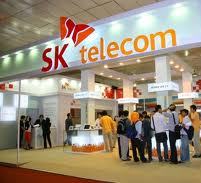  SK Telecom on Thursday said that it successfully demonstrated a core LTE-Advanced technology named 'Enhanced Inter Cell Interference Coordination (eICIC)' under cooperation with Qualcomm, a world leader in 3G and next generation mobile technologies, and Nokia Siemens Networks, the world's specialist in mobile broadband.
eICIC is a technology that coordinates signal interference between macro and pico base stations and is rapidly gaining importance as more and more micro base stations are being built in traffic concentrated areas to accommodate explosive data traffic growth, thereby aggravating inter cell interference.
To demonstrate the technology, SK Telecom, Nokia Siemens Networks and Qualcomm created an environment where the strength of micro base station signals being transmitted to mobile devices was weaker than that of nearby macro base signals, resulting in signal interference. Then, they applied eICIC to prove that it can actually control the interference and stabilize data communications. The companies also succeeded in showing that the technology is capable of offloading data traffic by adjusting the coverage of micro base stations based on the level of data traffic concentration in macro and micro base stations. As commercial base station equipment has been used for the demonstration, the companies are expecting to achieve early commercialization of eICIC.
With the successful demonstration of eICIC, SK Telecom gained an important edge in commercializing the next-generation telecommunications network as it now holds the record of demonstrating the three core technologies needed to usher in the era of LTE-Advanced: eICIC, Coordinated Multi-Point (CoMP) and Carrier Aggregation (CA). The company successfully demonstrated CoMP at Mobile World Congress (MWC) 2011 and CA at MWC 2012. At present, SK Telecom is the only company in the world that has succeeded in demonstrating all these three technologies.
CoMP is a technology that prevents base station interference and abrupt call disconnections in coverage boundary areas by enhancing signal strength, the lack of which leads to a significant drop in data transmission speed, and CA is a technology that provides twice or faster data rates by utilizing multiple frequency bands at the same time.
SK Telecom expects to commercialize eICIC in the second half of 2013 to control signal interference and effectively offload data in downtown areas that experience heavy data traffic so as to provide customers with a mobile data service with greater speed and stability.
The company commercialized CoMP, for the first time in the world, in January 2012, after adjusting the technology to suit the current LTE system, and plans to achieve early commercialization of CA in the second half of 2013.
Meanwhile, on June 14, a consortium between SK Telecom and the Electronics and Telecommunications Research Institute (ETRI, President Kim Heung-Nam) has been chosen by the Ministry of Knowledge Economy to carry out the Ministry-led project, aimed at developing next-generation LTE technologies.
Kang Jong Ryeol, Head of Network Technology R&D Center of SK Telecom said, "Building on its competitive LTE technologies, SK Telecom will make redoubled efforts to develop next generation network technologies to achieve early commercialization of LTE-Advanced by next year and secure technological leadership." |